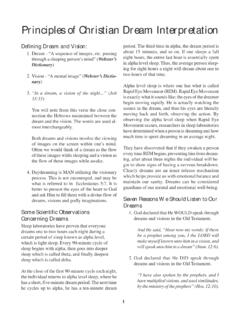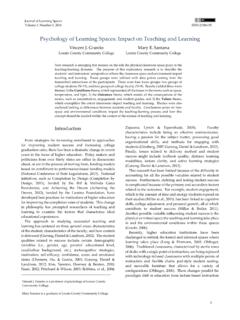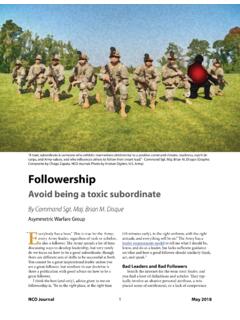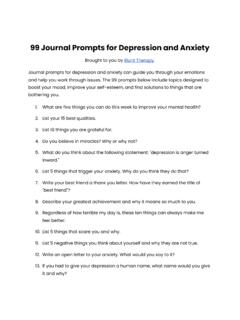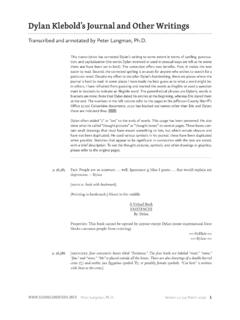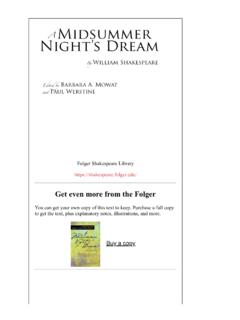Transcription of “Good Work Journal” Worksheet - Designing Your Life
1 Good Work journal Worksheet Use this Worksheet to reflect on your day and your week and ask yourself three questions: What did I learn? What did I initiate? and Who did I help? Research shows that noticing . these things will help you get more out of work and increase your engagement on the job. Try to have at least one entry a day. Date What did I learn? What did I initiate? Who did I help? Monday Tuesday Wednesday Thursday Friday Bonus Day Bonus Day 7TH DAY REFLECTION EXERCISE. Here's a simple four-step exercise you can do weekly. We recommend making it a regular practice to get the most out of it. Retreat Find a quiet spot where you can sit comfortably for five to ten minutes, either at a table or with a surface you can write on (preferably by hand, but typing is okay if you prefer). Close your eyes and just breathe for a moment. Take at least three or four full, calm breaths to slow yourself down and be glad that you're alive and have this quiet moment to yourself.
2 Review Now, while still keeping your eyes closed, let the last seven days flow before your mind's eye. As you do so, look for two to four moments in your week that you are attracted to and grateful for in retrospect. Note: Beware being attracted to problems, conflicts, forgotten to-do items, etc. The mind loves to get caught up in that stuff. When that stuff appears (and it will), just tell yourself, I'll get to that another time, and let it go. Don't fight it or attempt to resolve it both of which will steal all your attention. Just acknowledge it, then let it go and return to your reflection. Yes .. this takes some practice to get the hang of. As you review your week, being attentive to those 2 4 moments, very briefly jot down just one or two words for each such moment that stands out, so you won't lose it. cheerful grocer or finished essay or appeased boss.. Words_____. Reflect When you've got your list, look it over. Fully savor each of those moments again, getting the most out of them.
3 If one particularly pulls your attention, feel free to journal a bit further about the experience. Nothing long or dramatic just an entry to capture that experience. Reinforce & Retain Then reinforce your reflection by saying to yourself something like I'm really glad for these things. With these in mind, it was a good week. This is putting good enough for now to work proactively. That's it! And it really does take only five to ten minutes. Bonus Step - Insights If you notice that any of the moments you identified are offering an insight or a learning you want to capture, write that down, too. Insights don't always happen, but they're lovely when they do, so be sure and get yours when they're available. _____. _____. _____. Bonus Step Tell Your Story One way of getting the most out of your life is by giving it away through storytelling. Most of us get asked, Hey how's it going? at least once a week, if not more often. You could insert a story from your 7th Day Reflection in your answer.
4 It's going pretty well, actually. Why, just last week the checker at the grocery store ran out to the parking lot to return the credit card I'd dropped . how great is that? . _____. _____. _____. _____. _____. _____. Maker Mix Worksheet This graphic has sliders for three kinds of maker outputs - for the market economy, we will adjust Money in the mix; for the making-a-difference economy, we adjust Impact; and in the creativity economy, we will dial up Expression. Like our other graphic tools, the goal is to help you understand where you are today, and where you aspire to be tomorrow. You move the sliders intuitively and keep adjusting the mix of money, impact, and expression until it feels right. There are no units just a range from 0 to 100. 100 100. 0 0. Money Impact Expression Now design the mix you like in the future. Are you doubling down on money to pay off those students loans OK push that slider up. Or are you in a season of life where impact and expression are how you want to get paid.
5 Whatever the mix, make it fit for you. 100 100. 0 0. Money Impact Expression Now write down three things that will help you start moving in the direction of your preferred Maker Mix. _____. _____. _____. _____. _____. _____. _____. _____. _____. _____. Impact Map Worksheet List 4-6 roles (past, present and possible future). (a job might have several possible roles, each with a distinct place on the map). Locate the roles on the map. Far (global). Renew New Repair Sustain Support New Reflect: What do you notice? What insights does this generate? What questions does this surface? Near (personal). THE MINIMUM ACTIONABLE PROBLEM (MAP) TOOLKIT. Let's practice taking a look at our problems, a real problem in our work and/or our life and see if we can remove the drama and cut the problem down to size. Let's take a stab at coming up with our MAP. Pick a problem that you would like to work on but make sure it's a real problem, and one that you've been stuck on for a while.
6 Write the problem down, as clearly as you can. Writing it out will help you understand the frame that is implicit in the way you state the problem. Problem: First, examine the problem for any biases, embedded solutions, drama, or emotional components. This is challenging, because we often do not see our own biases. To do this well requires radical honesty, and a healthy dose of Accept. If you are struggling to state the problem objectively, ask a friend to help. Read them your problem statement and ask them to help you detect biases, embedded solutions, drama, or emotional components. Let them help you find a couple of MAPs. Once you have a few ideas about how to reframe your problem into a MAP, put your more objective, nonbiased reframe in the form of a How might we .. or a How might I .. statement. How Might I. _____. How Might I. _____. One you have a few MAP-ed problems, brainstorm (maybe with a friend) at least three different prototypes that you could try to resolve your problem.
7 Remember: We are setting the bar low here, accepting that a lot of problems can't be fully solved, and looking for a few good ideas for a re- solution for the MAP. Proto #1 - Proto #2. Proto #3. Best Doable Option (BDO) vs Best Theoretical Option (BTO) Exercise The trick here is to know the difference between the Best Doable Option (BDO), and the Best Theoretical Option (BTO). It frequently turns out that many of the really hard problems in life are best treated as multiple- choice tests. You don't really have to figure it all out all you have to know is enough to choose. That and the designer's mindset of bias to action and you are good to go. We call it finding the Best Doable Option (BDO).. It is very tempting to want to find the Best Theoretical Option (BTO). That's the option that you think you should be able to figure out; it's the one you deserve; and it's the one that probably doesn't actually exist! It's only in your head.
8 When you're distracted by the idea of the BTO, all the BDOs, the things you can actually do, seem like a compromise. They're all settling, and you don't want to settle. But you aren't actually settling, because an option that doesn't exist in reality isn't an option it's just an idea. Designers are all about making things real things. We want you to real- ize your dreams , not just dream them. So formulate the list of actually available options, then pick the best one. The Best Doable Option. Think about it. Despite many layers of complexity, lots of times there aren't infinite versions of possible solutions to your problem. And by taking a bias-to-action approach, you get unstuck, make a decision, and move into your future - a future that you chose instead of one that would eventually be chosen for you by inaction. When you get good at recognizing your BDOs, you get good at making actionable choices and are the designer of your future.
9 Pick a problem that you want to work on or something that you are actually working on and would like to find a good solution to. Problem: _____. Brainstorm at least five solutions to the problem as you currently understand it. Idea #1. Idea #2. Idea #3. Idea #4. Idea #5. Examine the options you've brainstormed and sort them into BTO and BDO categories Now eliminate your BTOs and focus on your BDOs. Resolve to have a bias to action, pick one, and execute it. Ask yourself, how do I feel? Remind yourself that, with that decision behind you, you now have more time to devote to other things. With that decision behind you (and be sure to separate the quality of the decision from the quality of the outcome), you are now free to tackle whatever is next. GETTING OVER OVERWHELM. Overwhelmed (Y/N)? Ask yourself if you feel continually overwhelmed are you really persistently overwhelmed or was it just one tough week? If yes, continue. If no - go play Frisbee or walk the dog, you deserve it.
10 Burned Out (Y/N)? Check if you're actually burned out or overwhelmed by reviewing the following burnout indicator questions from the Mayo Clinic. If you think you are headed for burnout, put the book down and immediately find yourself a therapist specializing in burnout and get good support. Mayo Clinic Checklist: Answering yes to two or more of these questions might indicate that you are burned out, or well on your way. Lack of control. You are not able to influence decisions that affect your job, such as your schedule, assignments, or workload. Unclear job expectations. You're unclear about the degree of authority you have or what your supervisor expect from you. Dysfunctional workplace dynamics. You work with an office bully, you feel undermined by colleagues, your boss micromanages your work, or there are lots of office politics that you don't understand. Mismatch in values. If your values differ from the way your employer does business or handles grievances, the mismatch can eventually take a toll.


